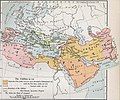Portal:Asia

 Asia (/ˈeɪʒə/ AY-zhə, UK also /ˈeɪʃə/ AY-shə) is the largest continent in the world by both land area and population. It covers an area of more than 44 million square kilometers, about 30% of Earth's total land area and 8% of Earth's total surface area. The continent, which has long been home to the majority of the human population, was the site of many of the first civilizations. Its 4.7 billion people constitute roughly 60% of the world's population. Asia shares the landmass of Eurasia with Europe, and of Afro-Eurasia with both Europe and Africa. In general terms, it is bounded on the east by the Pacific Ocean, on the south by the Indian Ocean, and on the north by the Arctic Ocean. The border of Asia with Europe is a historical and cultural construct, as there is no clear physical and geographical separation between them. A commonly accepted division places Asia to the east of the Suez Canal separating it from Africa; and to the east of the Turkish straits, the Ural Mountains and Ural River, and to the south of the Caucasus Mountains and the Caspian and Black seas, separating it from Europe. Since the concept of Asia derives from the term for the eastern region from a European perspective, Asia is the remaining vast area of Eurasia minus Europe. Therefore, Asia is a region where various independent cultures coexist rather than sharing a single culture, and the boundary between Europe is somewhat arbitrary and has moved since its first conception in classical antiquity. The division of Eurasia into two continents reflects East–West cultural differences, some of which vary on a spectrum. (Full article...) Featured article The Anbar campaign consisted of fighting between the United States military, together with Iraqi security forces, and Sunni insurgents in the western Iraqi governorate of Al Anbar. The Iraq War lasted from 2003 to 2011, but the majority of the fighting and counterinsurgency campaign in Anbar took place between April 2004 and September 2007. Although the fighting initially featured heavy urban warfare primarily between insurgents and U.S. Marines, insurgents in later years focused on ambushing the American and Iraqi security forces with improvised explosive devices (IEDs), large scale attacks on combat outposts, and car bombings. Almost 9,000 Iraqis and 1,335 Americans were killed in the campaign, many in the Euphrates River Valley and the Sunni Triangle around the cities of Fallujah and Ramadi. Al Anbar, the only Sunni-dominated province in Iraq, saw little fighting in the initial invasion. Following the fall of Baghdad it was occupied by the U.S. Army's 82nd Airborne Division. Violence began on 28 April 2003 when 17 Iraqis were killed in Fallujah by U.S. soldiers during an anti-American demonstration. In early 2004 the U.S. Army relinquished command of the governorate to the Marines. By April 2004 the governorate was in full-scale revolt. Savage fighting occurred in both Fallujah and Ramadi by the end of 2004, including the Second Battle of Fallujah. Violence escalated throughout 2005 and 2006 as the two sides struggled to secure the Western Euphrates River Valley. During this time, Al Qaeda in Iraq (AQI) became the governorate's main Sunni insurgent group and turned the provincial capital of Ramadi into its stronghold. The Marine Corps issued an intelligence report in late 2006 declaring that the governorate would be lost without a significant additional commitment of troops. (Full article...) Selected Country The Maldives, officially the Republic of Maldives, and historically known as the Maldive Islands, is a country and archipelagic state in South Asia in the Indian Ocean. The Maldives is southwest of Sri Lanka and India, about 750 kilometres (470 miles; 400 nautical miles) from the Asian continent's mainland. The Maldives' chain of 26 atolls stretches across the equator from Ihavandhippolhu Atoll in the north to Addu Atoll in the south. The Maldives is the smallest country in Asia. Including the sea, the territory spans roughly 90,000 square kilometres (35,000 sq mi), with a land area of 298 square kilometres (115 sq mi). The Maldives is one of the world's most geographically dispersed sovereign states, and the smallest Muslim country by land area. With a population of 515,132 in the 2022 census, it is the 2nd least populous country in Asia and the ninth-smallest country in the world by area, but also one of the most densely populated countries in the world. (Full article...) Featured biography Al-Mukhtar ibn Abi Ubayd al-Thaqafi (Arabic: الْمُخْتَار ٱبْن أَبِي عُبَيْد الثَّقَفِيّ, romanized: al-Mukhtār ibn Abī ʿUbayd al-Thaqafī; c. 622 – 3 April 687) was a pro-Alid revolutionary based in Kufa, who led a rebellion against the Umayyad Caliphate in 685 and ruled over most of Iraq for eighteen months during the Second Fitna. Born in Ta'if, Mukhtar moved to Iraq at a young age and grew up in Kufa. Following the death of Husayn ibn Ali, a grandson of the Islamic prophet Muhammad, at the hands of the Umayyad army in the Battle of Karbala in 680, he allied with the rival caliph Abd Allah ibn al-Zubayr in Mecca, but the alliance was short-lived. Mukhtar returned to Kufa where he declared Muhammad ibn al-Hanafiyya, a son of caliph Ali (r. 656–661) and brother of Husayn, the mahdi and the imam, and called for the establishment of an Alid caliphate and retaliation for Husayn's killing. He took over Kufa in October 685, after expelling its Zubayrid governor, and later ordered the execution of those involved in the killing of Husayn. Hostile relations with Ibn al-Zubayr ultimately led to Mukhtar's death by the forces of the Zubayrid governor of Basra, Mus'ab ibn al-Zubayr, following a four-month siege. (Full article...) General imagesThe following are images from various Asia-related articles on Wikipedia. Featured picture Credit: Daniel Bachler A photo of two maiko (apprentice geisha), with the typical make-up clearly visible, leaving portions of the nape uncovered. This is done to accentuate what is a traditionally erotic area. The white face make-up is supposed to resemble a mask, and a line of bare skin around the hairline helps create that illusion. Established geisha generally wear full white face makeup characteristic of maiko only during special performances.
Did you know...
Updated: 6:33, 14 February 2024 In the news
Related portalsMajor Religions in Asia Middle East Central Asia and Caucasus Indian Subcontinent Southeast Asia East Asia Selected panorama
Bangalore, is the capital of the Indian state of Karnataka. It has a population of over ten million, making it a megacity and the third-most populous city and fifth-most populous urban agglomeration in India. TopicsCategoriesAssociated WikimediaThe following Wikimedia Foundation sister projects provide more on this subject:
More portalsShortcuts to this page: Asia portal • P:ASIA Purge server cache |




























































































